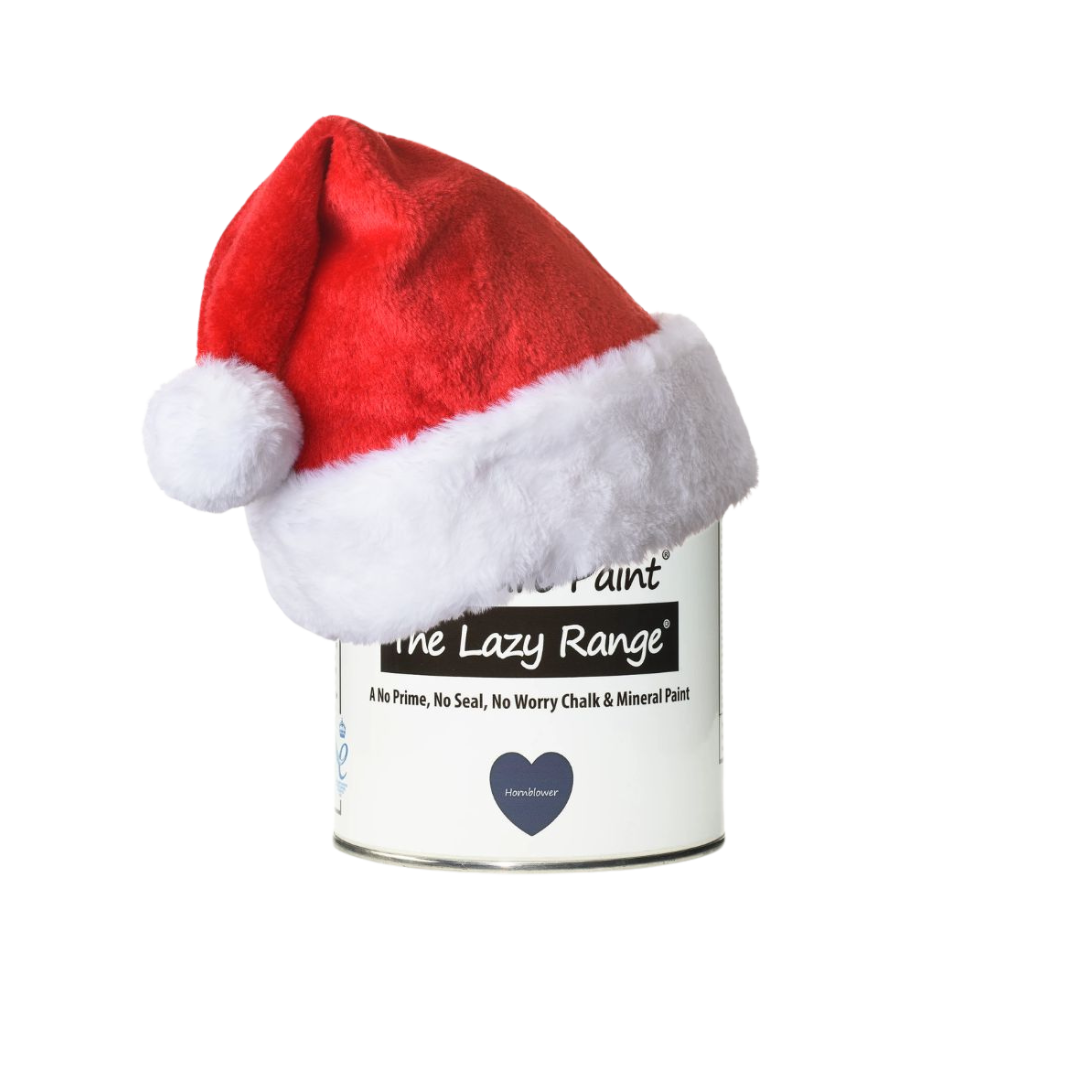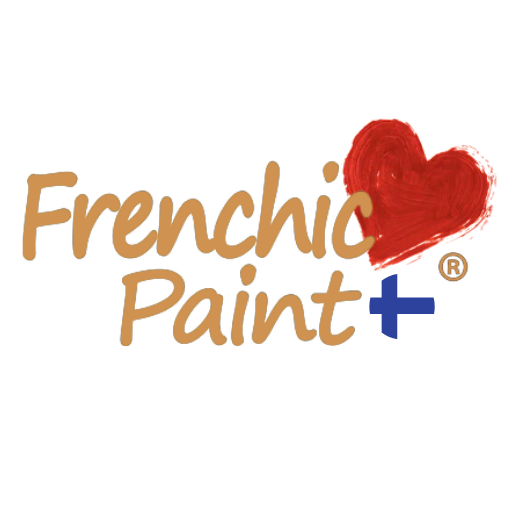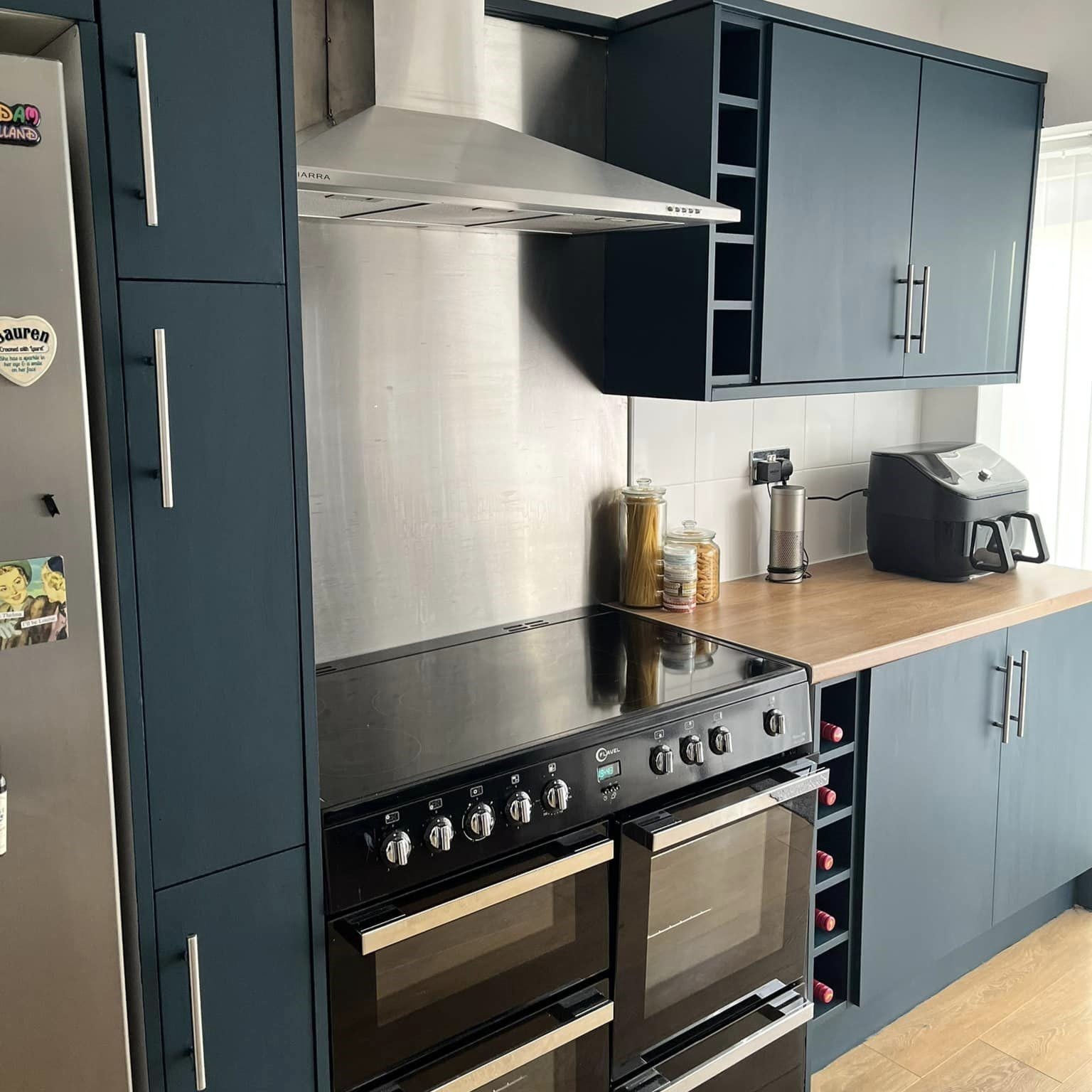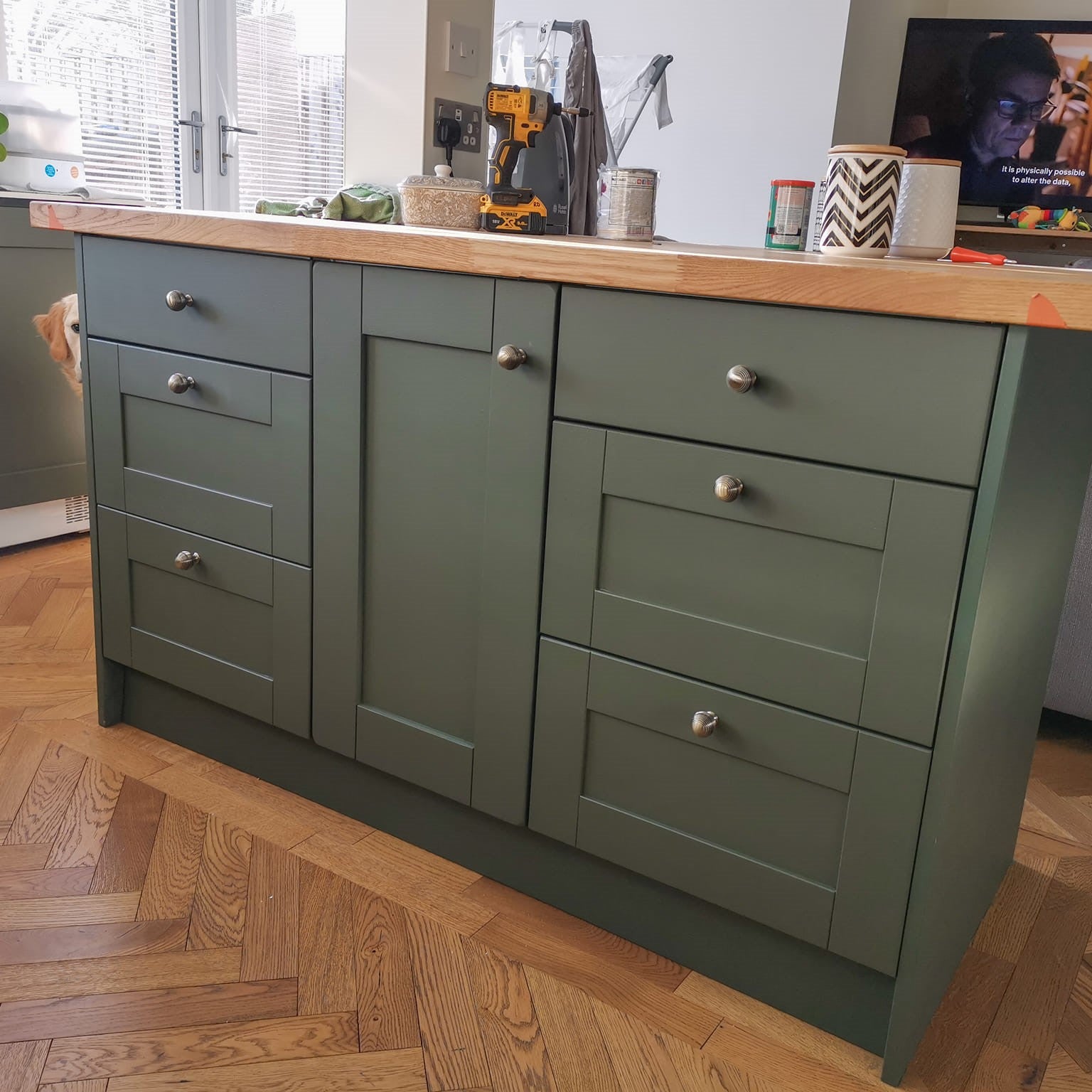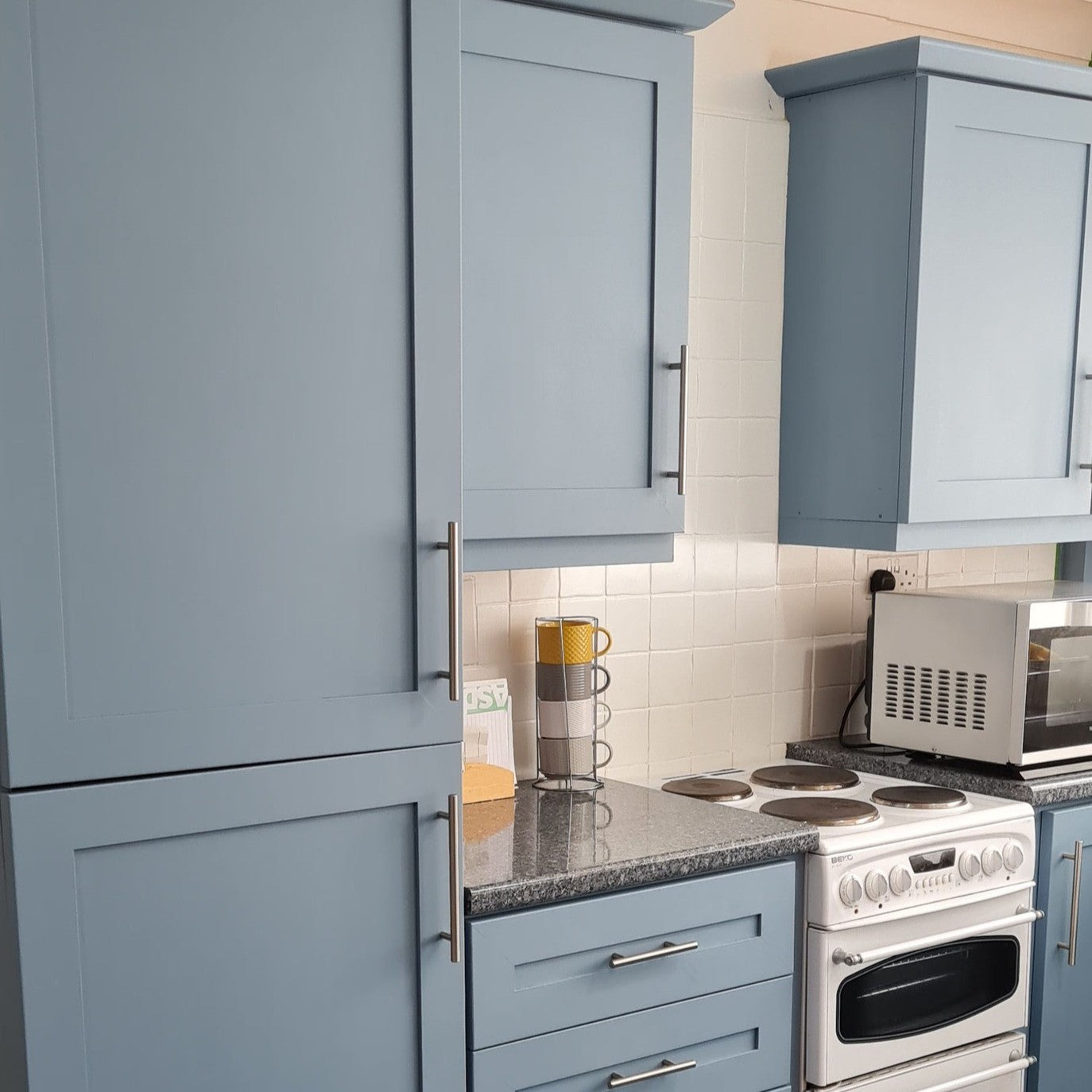Nybörjarguide
Målning av möbler är nu IN - och med god anledning
Återvinningsinredning är på uppgång och renovering av begagnade möbler är modernt och klokt - gör-det-själv, återvinning och återanvändning av gamla möbler är knappast en förbigående trend.
Skapa och måla om dina gamla möbler till vackra och moderna - du behöver inte alltid köpa nytt!
Om du någonsin har tyckt att chalk paint-färger inte är hållbara eller av hög kvalitet, är det nu dags att prova Frenchic Paint!
Målningsinstruktionerna för ett lyckat resultat är i slutändan mycket enkla med Frenchic Paint:
- Tvätta och rengör ytan som ska målas noggrant och låt ytan torka.
- Slipa hela ytan och torka bort slipdammet.
- Måla minst två gånger på en torr och ren yta med noggrant omrörd färg.
- Låt torka enligt anvisningarna.
Nya egenskaper i våra färger!
Våra färger har prisbelönta, helt nya egenskaper som du inte hittar i andra serier!
Som den fina 'Self Levelling' egenskapen, vilket betyder att färgen jämnar ut sig själv och slutresultatet blir en perfekt, jämn och slät yta oavsett om du målar med roller eller pensel.
Eller 'Self Sealing', vilket betyder att ytan förseglas själv och du behöver inte applicera vax eller lack separat på ytan, som med vanliga kalkfärger. Möbeln blir mycket slitstark i vardagen bara genom att måla den.
'Self Priming' betyder att du inte behöver några speciella grund- eller fästmålar när du använder Frenchic Paint-seriens färger. Frenchic Paint-seriens färger har utmärkt vidhäftning.
Dessa egenskaper tillsammans med giftfrihet och puderiga matta ytor har snabbt gjort Frenchic Paint-serien till den mest populära kalkfärgsserien bland inrednings- och möbelmålare.
Varför skulle jag måla mina möbler med kalkfärg?
Med kalkfärg går arbetet snabbt och behagligt även vid inomhusmålning
Frenchic-kalkfärger är giftfria. De vattenbaserade Frenchic-färgerna är behagliga att måla med inomhus, de torkar snabbare än vanliga möbelfärger, är doftfria och verktygen rengörs enkelt med vatten och mild tvål.
Bekanta dig och testa först, innan ett större projekt
Skaffa en liten 250 ml testburk och prova färgen.
Konsistens och nyanser
Kalkfärger har ofta mycket bättre pigment och täckförmåga än vanliga möbelfärger - konsistensen är också ofta tjockare och droppfri.
En fantastisk matt yta är perfekt både för modern inredning och gamla byggnader. De puderiga pastellfärgerna påminner om våra traditionella nyanser och passar bra ihop med träytor eller vitt och grått.
Gör en miljövänlig insats och rädda dina gamla möbler från vinden eller källaren till en ny paradplats
Ofta är äldre möbler helt i trä och tillverkade för att hålla - men en gulnad eller mörknad träyta passar inte längre in i dagens inredning som den är.
Det är dock inte alltid vettigt eller nödvändigt att köpa nya möbler, med en liten mängd färg kan du enkelt förnya skåp, byråer och andra småmöbler till en elegant stil - utan designmöbelns prislapp!
Gör ditt hem personligt och använd de nyanser du själv gillar - det är bara med färger du skapar den nya stämningen. Tveka inte att måla om - du kan ofta byta färg på väggar, dörrar eller möbler - ditt hem lever i tiden och det ska synas även i färgerna - genom att måla ändrar du lätt rummets atmosfär.
Förutom möbler kan du börja med mindre målningsobjekt i ditt hem
På väggar, lister, karmar eller trappor hittar du fler små projekt - ett färgat golv eller ett färgat område i form av ett bågfönster kan göra intryck till exempel i barnrummet.
Trappor behöver inte målas helt på en gång, du kan prova att måla trappstegens framsidor eller bara räckena.
Skapa enkelt en färgstark målad rand i halvpanelhöjd på hallväggen, en pepparkakskantad halvvägsmålning eller en dramatisk mörk rektangel på sovrumsväggen vid sänggaveln!
De puderiga och mjuka Frenchic-färgerna passar vackert in i skandinavisk inredning tillsammans med trätoner, medan de mörkare nyanserna passar en djärv inredningsstil.
Oavsett om du tänker måla möbler för dig själv eller professionellt för försäljning - är en högkvalitativ kalkfärg avsedd för möbelmålning ett utmärkt alternativ.
Har du målning av köksskåp i åtanke?
Har du ett större målningsprojekt i åtanke, som målning av köksskåp eller liknande? Skaffa först några små testburkar på 250 ml färg, pensel, roller och färgkarta.
Om du inte har målat mycket tidigare rekommenderar vi att du gör ett litet övningsprojekt.
Skaffa en liten möbel med låda och dörr – som i ditt kök – och prova några nyanser du tänkt välja till ditt större projekt.
I denna övningsbit får du prova olika verktyg: slip-svamp, pensel och roller – och märker hur färgen beter sig; torkar och täcker.
Gör samma förberedelser på denna lilla övningsmöbel som du skulle göra på en större: tvätta ytorna med Sugar Soap möbeltvätt, skölj bort rengöringsmedlet och torka ytan – ta bort handtagen och kontrollera om hål behöver spacklas. Måla.
Ta bilder före och efter!
Målning av möbel – så lyckas du
1. Välj färg och undersök alternativen
En tumregel är att en liter kalkfärg räcker till cirka 13 m2. Det motsvarar ungefär en normalstor byrå eller skåp. Frenchic Paint-seriens färger räcker till ca 13,5 m2 per stor färgburk, 750 ml.
Du kan välja en nyans till inomhusmöbler från vilken Frenchic Paint-serie som helst.
På grund av kalkfärgens starka vidhäftningsegenskaper kan den användas på flera material, såsom metall, trä, glas, betong.
Tips! När du målar från svart till vitt eller tvärtom – eller mörkt och rödaktigt trä till vitt: måla första lagret med en grå nyans. Det dämpar mörkheten och rödheten och du behöver färre vita lager.
Välj möbel- eller väggfärg utan giftiga ämnen eller obehaglig doft – det är viktigt när man målar inomhus eller professionellt mycket. Du kan också välja lättanvända möbelfärger med skyddsegenskaper redan i färgen – 'just paint and go!'
När du målar bruksföremål bör du undvika tubfärger och hobbyfärger avsedda för pyssel.
Hållbar Frenchic Paint-seriefärg för målning av möbler eller köksskåp
Välj kalkfärger för möbelmålning som inte kräver grund- eller fästmålar 'Self Priming', och färger vars yta jämnar ut sig vackert av sig själv, 'Self Levelling', samt färger vars yta inte längre behöver skyddas som vanliga kalkfärger, 'Self Sealing'. Du kan läsa mer om Frenchic Paints 'Self Priming'-egenskap här.
Renovering, målning och återanvändning av gamla möbler är återbruk av inredning när det är som bäst!
Satsa på penseln och undvik engångsverktyg
Det lönar sig att satsa på en kvalitativ pensel som är tillverkad för möbelkalkmålning. Om du använder gamla, slitna och smutsiga billiga penslar kan slutresultatet av ditt målningsprojekt bli långt ifrån önskat.

Bild: De bästa penslarna för kalkmålning är ovala.
Instruktioner och blogginlägg om att välja rätt pensel, läs det här.
Måla endast rena ytor
Börja med att rengöra ytan som ska målas.
Ta bort handtag och knoppar om du vill. Torka bort all smuts och fett – måla alltid bara rena ytor. Sugar Soap är Frenchic Paint-seriens eget rengöringsmedel för möbler.
Även en möbel som ser ren ut kan släppa ifrån sig mycket smuts. Frenchic Paint-seriens färger har utmärkta vidhäftningsegenskaper, så se till med noggrann rengöring att inget onödigt finns kvar mellan ytan som ska målas och färgen.


Den dryga Sugar Soap-koncentratet rengör ytorna lätt för målning. Oavsett vilket rengöringsmedel du använder, skölj alltid bort det använda rengöringsmedlet från ytan med rent vatten till slut.
Tejpa och avgränsa de områden du inte vill måla
Tejpning är ett smidigt sätt att avgränsa färgen där du inte vill ha den: dörrhandtag, knoppar eller glasets kanter. Tejpning ger snygga målningskanter. Välj en kvalitets tejp när du vill ha riktigt exakta avgränsningar. Med billigare maskeringstejp kan du fästa skyddspapper.
Börja målningen med noggrant omrörd färg
När du har skyddat golvet under möbeln som ska målas är det dags att måla!
Använd din pensel med lätt hand från botten uppåt. Måla med långa drag i träets riktning – kom ihåg att kalkfärgen torkar snabbt.
Övermåla inte en yta som redan torkar, utan låt lagren torka enligt anvisningarna – gå sedan tillbaka för att bättringsmåla. För tunna färglager kan lämna penseldrag tydligt synliga när det tunna färglagret torkar snabbt.
Frenchic Paint-seriens färger har en 'self levelling'-egenskap som jämnar ut färgen när den torkar. Lagret får då inte vara för tunt. Frenchic Paint behöver inte spädas.
Om du målar mörkt till ljust (eller tvärtom) kan det krävas flera lager för att ytan ska täckas helt och jämnt. Tips för detta: måla första lagret med grått, så klarar du dig med färre lager.
Som tur är behöver du inte vänta länge, eftersom kalkfärgen torkar snabbt och du kan snart fortsätta. Om du vill ha en lite mer sliten stil kan två lager vara tillräckligt.
Med Frenchic-seriens färger målar man alltid minst två lager.
Slita till en gammal look (om du vill)
Detta steg är verkligen inte obligatoriskt, men vi nämner det eftersom det är en så populär stil. Det viktigaste med slitningen är att få den att se naturlig ut, så slitningen bör naturligtvis göras på de delar av möbeln som slits: runt handtag och knoppar, kanter, hörn och kanske lite här och där.
Slitningar kan göras med flera olika tekniker: använd slipsvamp och rugga lätt upp ytan eller använd en fuktig trasa och gnugga upp färgytan med cirkulära rörelser – då blir slitningsområdena naturligt mjukt avrundade.
Efter slitage/slipning, torka ytorna rena igen. Lär dig göra olika slitningseffekter och tekniker, läs instruktionerna här.
Avsluta med vax om du vill
Vaxet skyddar kalkfärgade ytor och ger extra hållbarhet. Vaxet fördjupar också kalkfärgens nyans och håller ytan i gott skick under kommande år.
Färgat vax skapar en vacker patina på ytan.
När ytan är torr och ren, applicera klart vax på önskad yta med hjälp av vaxpensel. Ta bara lite möbelvax på penseln åt gången, det är mycket drygt och lätt att applicera. Vaxa alltså först med måtta – du kan lägga till ett nytt tunt lager vax om du vill.
Efter varje vaxning torkas överflödigt vax bort med en luddfri trasa. Vaxet torkar snabbt vid beröring, men härdar fortfarande i cirka 21 dagar vid normal rumstemperatur.
Läs mer om användning av vax här.
Om du använder Frenchic-seriens Lazy Range, Trim Paint eller Al Fresco-seriens färger, och inte sliter på färgytan, kan du om du vill hoppa över detta steg.
Frenchic Paint har skyddsegenskaperna redan färdiga i färgen.
Självklart kan du också vaxa med dessa serier när du målar – och på så sätt ge möbeln patina och djup.
Ta ett steg tillbaka och beundra!
Dina möbler är redo att säljas eller placeras på hedersplats i ditt hem. Nu kan du börja fundera på nya målningsprojekt!
Bli inspirerad och beundra Frenchic-projekt i vår Facebook-grupp!
